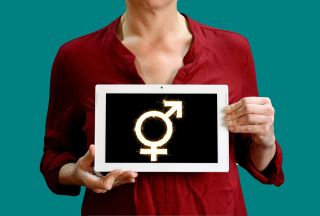Gender
Hormones Determine Sex More Than Genetics
Intersex disorders elucidate the hormonal mechanisms of sex differentiation.
Updated November 8, 2023 Reviewed by Ray Parker
Key points
- Over 99% of people are unambiguously male or female: hormones, physiology, and chromosomes align.
- Intersex disorders are usually the result of excess androgens in females or insufficient androgens in males.
- These disorders show that, more so than genes, prenatal hormone exposure determines sex differentiation.

Most people assume that our genes determine the characteristics that make males and females distinct from each other: sex organs, secondary sex characteristics, personality, behavior, and even reproductive capacity. That is all true, but in a far more indirect way than you'd think. Hormones are the real stars of the show.
The Female Blank Slate
At conception, every human inherits 23 pairs of chromosomes, including the sex chromosomes that define genetic sex: XX for females and XY for males. However, irrespective of whether the fetus is genetically male or female, it initially follows an anatomically female developmental pathway. This stage is often called the "female blank slate."
The first few weeks of embryonic growth do not show any discernible differences between the two sexes. It's not until approximately the sixth week of gestation that the sex chromosomes determine which types of gonads are developed: testes in males or ovaries in females.
Sex hormones produced by the gonads—testosterone by the testes and estrogen by the ovaries—then drive further sex differentiation, including the development of the reproductive organs and subtle organizational changes in the brain.
Sex Differentiation in the Brain
As a result of these hormonal changes, early in utero and during a surge period in the first few months of life known as "minipuberty," male and female brains begin to wire differently. It's thought that many of these organizational brain changes due to prenatal hormone exposure directly contribute to the sex differences observed in the behavior and personalities of children and adults.
How do we know this? Isn't it possible that gender differences are the result of gendered socialization—boys and girls being treated differently, in subtle ways, from the moment of birth—which merely coincides with different sex hormone levels?
There are a few rare intersex disorders that shed light on these questions.
Female Genes, Male Hormones
The most common intersex disorder in humans is congenital adrenal hyperplasia (CAH). Congenital, meaning present from birth, and adrenal hyperplasia, meaning overactive adrenal glands.
Children with CAH have a deficiency in cortisol, our body's primary stress hormone. While chronically high cortisol is toxic to the body, in short bursts, it is essential for our body's fight or flight survival response, and a small baseline amount of cortisol is necessary for critical basic survival functions such as regulating metabolism.
Therefore, with the cortisol deficiency present in CAH, the body signals to the adrenal glands—where cortisol is produced—to work harder. As a side effect of this, the adrenals also produce other androgens (masculinizing hormones) in excess, including androstenedione, a precursor to testosterone.
CAH can be deadly if left untreated, but it is almost always diagnosed shortly after birth. Children are treated with glucocorticoids (cortisol supplements), and the adrenal glands calm down. However, they were still exposed to higher-than-average levels of androgens prenatally.
What happens as a result of this?
In males, nothing interesting. Their testes were already producing testosterone, and a bit more from the adrenals didn't change much. In females, it's a whole different story.
Females have much lower levels of testosterone than males. Prenatally, males are exposed to over five times as much, and after puberty, up to 20 times as much. Females with CAH, however, have several times more testosterone exposure than typically developing females, nearing male-typical levels.
As a result of this, CAH is classified as an intersex disorder. Chronically high androgen exposure can masculinize female genitalia, leading to ambiguous sexual presentation, but CAH is usually treated early enough (before minipuberty) that this doesn't happen.
Most girls with CAH go on to live healthy lives as women, with perfectly functioning reproductive tracts. The most significant effects of CAH, therefore, are the subtle neurodevelopmental effects of prenatal testosterone.
Females with CAH have structural and functional brain differences, leading to lifelong personality changes. Girls with CAH are more aggressive and tomboyish during childhood and exhibit more masculine play preferences. And women with CAH are much more likely to identify as lesbian during adulthood.
As dramatic as these changes sound, they still fall within the range of typical variability. Many women are more masculine or more attracted to women than the average man.
An even rarer intersex disorder, however, leads to even more dramatic and interesting changes.
Male Genes, Female Hormones
Looking at the other end of the spectrum, there's the condition known as complete androgen insensitivity syndrome (CAIS). People with CAIS have androgens like testosterone circulating in the body, but they do not bind to androgen receptors properly. They are functionally inert.
What happens in females with CAIS? Perhaps enviously, people with CAIS will not develop body hair, body odor, or acne. The development of these traits during puberty are all driven by androgens, even in females. Other than that, there are no significant impacts on women. Ovarian hormones like estrogen and progesterone are enough to guide healthy female development.
A complete lack of male hormones has much more dramatic effects on males. Remember, all the Y chromosome does is genetically program the testes' development during the first six weeks of fetal development. From then on, testosterone produced by the testes drives all further sex differentiation, including genital development.
This might imply that genetic males with CAIS might be born with no genitals or sex-specific traits at all, an opposite extreme compared to intersex disorders involving ambiguous presentation with both masculine and feminine traits. But interestingly, that's not the case.
Remember the idea of the "female blank slate." All prepubescent males have roughly the same levels of female sex hormones as females, but their effects are normally inhibited by androgens.
In males with CAIS, the small amounts of estrogen and progesterone are enough to facilitate female-typical development. At birth, they will present with an unambiguously female vagina. But inside their abdomens, instead of ovaries, they have testes producing testosterone that their bodies cannot use.
These XY-children will grow up as perfectly healthy girls, but now you might think: They don't have ovaries, and their testes don't work. They must be destined to live their lives as prepubescent girls, unable to go through male or female puberty.
That is also not true. Surprisingly, the small amounts of estrogen and progesterone present in males are enough for female puberty: breast growth, fat redistribution around the hips, and the development of other female-specific traits. These effects are normally inhibited by androgens in males. But males with CAIS will go through female puberty, too.
Typically, XY-girls with CAIS are not diagnosed until their late teens, after having gone through all features of puberty but strangely never getting their first period. They find out they don't have ovaries and can never menstruate or bear children.
But despite their XY chromosomes and testes, they go on to live their lives as healthy women and externally have all of the same features as women. They are also just as likely to be attracted to men as heterosexual women, indicating that whatever determines sexuality is more likely to be hormonal or environmental than genetic.
Male or Female?
I began by calling XY fetuses with CAIS male, then switched to calling them women. Are they male or female?
It's complicated.
Genetically, they are male. They have all the same characteristics as females (except ovaries). Socially, they were raised as girls and women. And reproductively—the most common definition of sex used by evolutionary biologists, defined by whether an organism produces eggs or sperm—they are neither.
These extreme cases of intersexuality have extremely fuzzy borders, and it becomes useful to distinguish between genetic sex, reproductive sex, medical sex, and gender socialization.
But in over 99 percent of cases, most humans are unambiguously male or female. Much more so than by genes, however, sex differentiation is driven by sex hormones.




